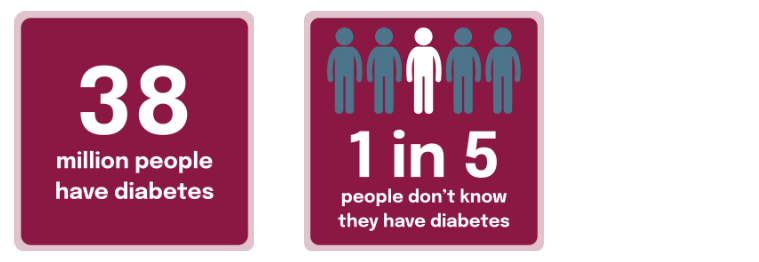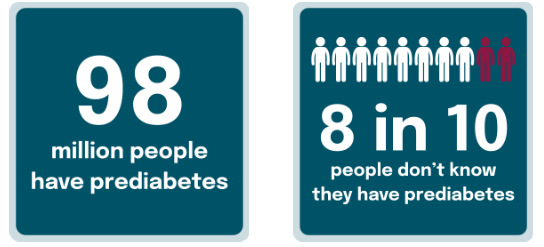What is Diabetes?
Diabetes is a chronic condition that affects how your body turns food into energy. Normally, your body breaks down food into glucose (sugar), which enters your bloodstream. Insulin, a hormone made by the pancreas, helps move glucose into your cells for energy. With diabetes, your body either doesn’t make enough insulin or can’t use it properly. This leads to high blood sugar, which over time can cause serious health problems like heart disease, kidney failure, and vision loss.
More than 24 million people in the U.S.A. have diabetes.
1 in 5 people with diabetes do not know they have it.
Diabetes is the #1 cause of kidney failure, lower-limb amputations, and adult blindness.
What is Prediabetes?
More than 88 million adults in the U.S.A. have prediabetes
8 in 10 prediabetic adults do not know they have it
Prediabetes means your blood sugar is higher than normal but not high enough to be diagnosed as diabetes. It increases your risk for type 2 diabetes, heart disease, and stroke.
The good news: Prediabetes can often be reversed with lifestyle changes like healthy eating, physical activity, and weight loss. Programs like the Diabetes Prevention Program can help.
To find out if you are at risk, you can have your doctor check your blood glucose levels. You can alsotake this simple risk test. A score of 5 or more indicates that you are at a higher risk of having prediabetes.
Types of Diabetes
Type 1 Diabetes: An autoimmune condition where the body attacks insulin-producing cells. Usually diagnosed in children or young adults. Requires daily insulin.
Type 2 Diabetes: The most common type (95% of cases). Often develops slowly and may go unnoticed. Linked to insulin resistance and lifestyle factors.
Gestational Diabetes: Develops during pregnancy. Usually goes away after birth but increases the risk of type 2 diabetes later in life.
Risk Factors for Type 2 Diabetes
You’re more likely to develop type 2 diabetes if you:
Have prediabetes
Are overweight
Are physically inactive (less than 3 days/week)
Are age 45 or older
Have a family history of diabetes
Had gestational diabetes or a baby over 9 lbs.
People of all races and ethnicities can develop type 2 diabetes, but people who are Black, Hispanic, Native American, or Asian American/Pacific Islander have a higher risk
Know Your Numbers: Are you at Risk?
To know if you have prediabetes or diabetes, get tested. Common tests include:
Fasting Blood Sugar
A1C
Oral Glucose Tolerance Test
Learn more about Diabetes and the various blood tests at the CDC website: https://www.cdc.gov/diabetes/basics/getting-tested.html
Managing Type 2 Diabetes
Living well with type 2 diabetes starts with a personalized care plan. Your healthcare team—doctors, dietitians, pharmacists, and diabetes educators—can help you make informed choices about:
Eating a balanced diet
Being physically active
Taking medications or insulin if prescribed
Managing stress
Attending regular checkups
Diabetes Self-Management Education and Support (DSMES) services offer tools and guidance to help you take control of your health. Ask your doctor for a referral to DSMES and explore local programs like Virginia Cooperative Extension’s Balanced Living with Diabetes for additional support.




